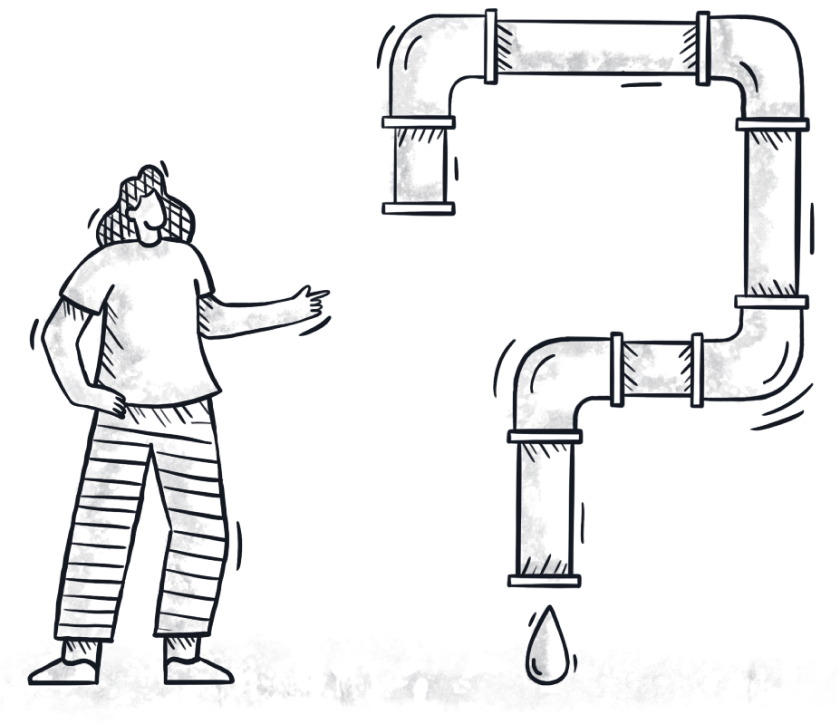Response Monitoring
Response Monitoring is a continuous process that tracks the delivery of a humanitarian sanitation intervention against its targets. It is used to systematically measure progress and to ensure the quality of sanitation services and their compliance with legislation and quality Standards along the Sanitation Service Chain. It aims to ensure that allocated funds are being used effectively, feedback is heard and acted upon and strengths, weaknesses and gaps are identified so that changes can be made as needed. Effective monitoring requires a monitoring plan and access to clear guidance on standards combined with the appropriate institutional, financial and human resources and infrastructural and access arrangements required to carry out monitoring activities. Monitoring is essential for all steps of the sanitation service chain. In practice, the monitoring of sanitation interventions is often combined with the monitoring of all other WASH activities.
-
- Use existing national standards if available or internationally recognised standards (such as Sphere or the GWC Sanitation Quality Standards) to support the identification of key actions and indicators and contribute to quality and accountability
-
- Draw up a specific monitoring plan at the beginning of the programme with a timeframe, budget and a clear indication of staffing and responsibilities. Adjust this plan according to the progress of the programme. Update the monitoring plan as the programme evolves
-
- Focus on collecting data that is essential or useful to know, rather than nice to know. Plan according to the available resources for monitoring and only collect data that will be analysed and used
-
- Define and follow a formal monitoring plan
-
- Share the monitoring data on latrine access and usage with communities in order to agree on programme adaptations where possible
-
- Have SOPs in place for programme activities like desludging so these activities can be monitored against the SOPs
-
- Use the information collected through the monitoring system to improve the operational procedure and planning. For example, the frequency of sludge extraction from a settling-thickening tank or a waste stabilisation pond can be adjusted based on the observed quantity of sludge accumulated over time
-
- Adjust monitoring parameters depending on the technologies used, the local effluent discharge standards and the end-use objectives.
-
- Involve the community in the monitoring process instead of treating them solely as the objects of monitoring
-
- Share the monitoring plan with different stakeholders, e.g. the community, partners, donors and other organisations, in a format that is accessible and easy to understand so that it can be used for decision-making.
-
- Coordinate monitoring requirements and plans with humanitarian WASH cluster/sector partners to allow joint activity reporting (see example FSTP monitoring dashboard from WASH sector Cox’s Bazar in the ’Key Resources and Tools’ below).
Monitoring the implementation of sanitation infrastructure and services and its continuous operation, maintenance and use is essential to ensure professional and safe sanitation service provision. Monitoring is important because it tracks progress and quality and checks whether the programme is being implemented according to plan and agreed standards.
Monitoring aims to ensure that the sanitation programme is going according to plan, achieves its stated goal, meaningfully involves all the key stakeholders and acts on lessons learned throughout the process so that the programme remains relevant and of good quality.
Monitoring should be planned and systematic; indicators for monitoring the objectives should be developed as early as possible in the programme based on national or, if not available or applicable, internationally agreed sanitation and Faecal Sludge Management (FSM) Standards. In an emergency, the monitoring system needs to be simple, fast and flexible.
The parameters to be monitored and the suitable frequency of monitoring depend on the programme activities and the phase of the emergency. Often, in the first months of a response, fewer (often quantitative) parameters are monitored at a higher frequency compared to later in the response, where more (often qualitative) parameters are monitored at a reduced frequency.
Different aspects of a sanitation programme need to be monitored: the processes (e.g. whether latrines and treatment plants are constructed with the active participation of the community, or whether there are changes in context), the activities and outputs (e.g. the number of latrines being built or sanitation workers that have been trained) and the outcomes (e.g. whether latrines are being used, whether pits and septic tanks are regularly desludged or whether faecal sludge treatment plants are properly operated in compliance with legislation and Quality Standards and corresponding laboratory tested performance indicators).
Monitoring is not a one-off activity, but a continuous process that compares progress with the project or programme design, tracks changes in the context and people’s needs and identifies appropriate corrections during the response to increase the programme’s effectiveness. Monitoring data should feed into the Evaluation.
The minimum monitoring requirements and monitoring methods used depend on the implemented sanitation systems and delivered services. Monitoring requires a dedicated budget as it is time-consuming and requires finances, trained staff and sometimes infrastructure (such as a laboratory).
A written monitoring plan is essential and will assist operators in collecting and organising the data that is required and ensuring it is relevant and accurate. This plan needs to describe 1. Why the information is required; 2. What information will be obtained; 3. How and when the information or samples will be collected; and 4. Who will collect them.
In many emergency responses, sanitation activities are monitored simultaneously with all other WASH activities. Many operational WASH clusters use a 4W template to track Who is doing What, Where and When.
The different components of the sanitation service chain require different monitoring methods:
Onsite User Interface/Collection and Storage
Typical parameters to be monitored include:
-
- # of shared latrines constructed as per agreed standards
-
- # of household latrines constructed as per agreed standards
-
- # of latrines decommissioned
-
- # of child-friendly latrines constructed as per agreed standards
-
- # of latrines maintained/cleaned
-
- # of latrines repaired
-
- % of people asked for input on the design and construction of facilities who feel that their input was taken into account
-
- % of people reporting being happy with the facilities they use
Latrine access, quality, use and user satisfaction need to be monitored through a combination of household surveys, routine sanitary inspections and continuous user feedback mechanisms (such as Key Informant Interviews, Focus Group Discussions, Household Visits or Transect Walks). Example household questionnaires and guidance on sanitary inspections (JMP, Guidance for Monitoring Safely Managed On-Site Sanitation, SMOSS) can be found in the ‘Key Resources and Tools’ below.
The monitoring data on latrine access and user satisfaction should be shared with communities as part of regular user consultations in order to agree on programme adaptations where possible.
For desludging and conveyance monitoring it is essential to have Standard Operating Procedures (SOPs) in place to monitor against. For example, the use of personal protective equipment must be incorporated into the SOP and routine checks conducted to monitor the usage and other factors leading to safe working environments. Based on the specific programme, the following indicators could be monitored:
-
- SOP for desludging and transport
-
- # of latrines desludged
-
- m3 of Faecal sludge transported
-
- # of users satisfied with services (user feedback mechanism)
Faecal Sludge Treatment Plant (FTSP) Operations (Strande et al 2014)
The Operation and Maintenance of an FSTP involve a detailed understanding of the treatment processes and performance requirements. This understanding should be based on the theoretical information concerning the treatment mechanisms and the design of the technology as well as a monitoring procedure that requires specific planning, infrastructure (e.g. laboratory), employees, and finance. The monitoring programme should be structured to provide the operations employees with adequate information to continuously optimise the plant’s performance and to provide control over the effluent quality. Plant performance, therefore, needs to be monitored over time.
The monitoring plan of an FSTP may include a range of different methods such as:
-
- Visual or sensory inputs: including visual inspections of plant conditions, such as scum on a treatment lagoon, the colour of the sludge, or odours emanating from a pump tank
-
- Analysis or measurement at source: this includes test strips or kits that can be utilised in the field for measuring pH, dissolved oxygen, or temperature and
-
- Laboratory testing of samples (either onsite or offsite)
The parameters that are most often analysed include:
-
- Volume (m3) of faecal sludge treated
-
- Solid and suspended matter: these analyses assist in the evaluation of the settling and solid/liquid separation performances
-
- Moisture content of the end-products: this parameter provides an estimation of the drying performances
-
- Biological Oxygen Demand (BOD) and Chemical Oxygen Demand (COD) in the liquid fraction – an indirect measure of the amount of biodegradable organic material present in wastewater or faecal sludge: the more the organic content, the more oxygen is required to degrade it with a direct impact on aquatic life;
-
- Nutrient content (i.e. nitrogen and phosphorus): which influences the potential for resource recovery in agriculture, as well as the risk of eutrophication of water bodies and
-
- Pathogen content: this involves an evaluation of the presence and number of E. coli, faecal coliforms or helminths eggs which allows control of the risks related to waterborne diseases.
These monitoring parameters can be adjusted depending on the technologies used, the local effluent discharge standards and on the end-use objectives.
Laboratory monitoring requires strict procedures and skilled employees as well as significant funds to operate and maintain the analytical equipment and infrastructure and to purchase the required consumables. A specific laboratory budget is therefore required. Some technologies involve more complex laboratory monitoring to ensure an efficient process (e.g. composting, activated sludge, lime treatment), while others only require laboratory analyses to evaluate the treatment performances. Laboratories also require quality assurance and quality control (QA and QC) procedures. Although it is normally possible to send a faecal sludge sample to a specialised laboratory for analysis, in a humanitarian setting there may not be an accessible and functioning laboratory nearby. In this case, you can consider deploying an FSTP field laboratory (see ’Key Resources and Tools’ below).
-
Bibliography
Key Resources and Tools
Guidance for Monitoring Safely Managed On-Site Sanitation (SMOSS)
Example household sanitation surveys and guidance on sanitary inspections
Examples of WASH Cluster 4W. WASH Complied 4Ws
Examples of WASH cluster 4W, including sanitation parameters and the corresponding online dashboard
Examples of WASH Cluster 4W. Cox's Bazar WASH 4W Dashboard - Completed WASH Activities
Examples of WASH cluster 4W, including sanitation parameters and the corresponding online dashboard
FSTP Effluent Quality Monitoring Dashboard
Example of an FSTP effluent quality monitoring dashboard of the Cox's Bazar WASH sector
Faecal Sludge Management: Systems Approach for Implementation and Operation
FSM handbook including guidance on the creation of monitoring plans (Chapter 11)
Faecal Sludge Field Laboratory
Faecal sludge field laboratory website, including equipment lists and laboratory technicians' manuals
Methods for Faecal Sludge Analysis
Practical guidance on sampling and analysis techniques for faecal sludge
Daily Sanitation Facilities Operation & Maintenance Checklist 2023
DEWATS Monitoring Tool
Related Common Questions
Found what you were looking for?
Still have questions?
You could not find the information you were looking for? Please contact our helpdesk team of experts for direct and individual support.

